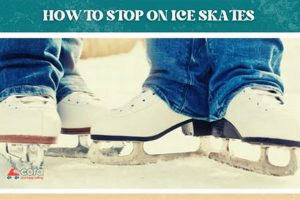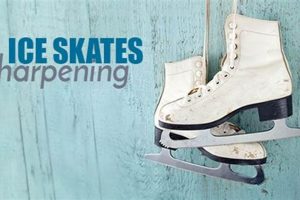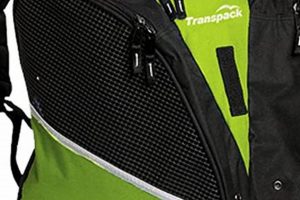The modification of a skating blade’s running surface to optimize performance is a critical process in figure skating and ice hockey. This process involves adjusting the blade’s curvature and edges to suit an individual skater’s biomechanics, skating style, and skill level. For example, a deeper hollow creates sharper edges, offering increased grip and control for intricate maneuvers, while a flatter profile promotes speed and glide.
Properly executed blade contouring offers significant advantages. It can enhance a skater’s agility, power, and stability on the ice. Historically, this procedure relied heavily on subjective assessment and manual techniques. Over time, technological advancements have introduced precision tools and methodologies, allowing for more consistent and repeatable results. The benefits include improved efficiency of movement, reduced fatigue, and a decreased risk of injury.
The following discussion will delve into specific techniques used to customize blades, the equipment involved, and the impact of these adjustments on various skating disciplines. Furthermore, the crucial role of skilled technicians and the ongoing evolution of blade customization within the sport will be examined.
Ice Skate Profiling
Optimizing blade configuration is essential for maximizing skating performance and minimizing potential risks. The following outlines key considerations for understanding and implementing effective blade contouring.
Tip 1: Understanding Blade Radius: The radius of the blade’s curve impacts maneuverability and glide. A smaller radius facilitates tighter turns, while a larger radius enhances straight-line speed. Choose a radius appropriate for the intended skating discipline and skill level.
Tip 2: Hollow Depth Selection: The depth of the hollow ground into the blade determines edge grip. Deeper hollows provide sharper edges for greater control but may sacrifice speed. Conversely, shallower hollows offer increased glide but reduced grip. Experimentation is essential to find an optimal balance.
Tip 3: Edge Sharpening Frequency: Regular edge maintenance is crucial for consistent performance. The frequency of sharpening depends on usage intensity and ice conditions. Dull edges compromise control and increase the risk of falls.
Tip 4: Professional Assessment: Consulting with a qualified technician is recommended for initial blade preparation and subsequent adjustments. A skilled professional can assess skating style and biomechanics to recommend appropriate blade configurations.
Tip 5: Consider Blade Material: Blade materials vary in hardness and durability. Harder steels retain their edge longer but may be more brittle. Consider the trade-offs between edge retention and impact resistance when selecting blades.
Tip 6: Consistent Monitoring: Regularly inspect blades for signs of wear, damage, or misalignment. Early detection of issues can prevent more significant problems and ensure continued optimal performance.
Tip 7: Record Adjustments: Maintain a detailed record of all blade adjustments, including radius, hollow depth, and sharpening dates. This documentation allows for consistent replication of successful configurations.
Properly configured blades are a crucial element of skating proficiency. Understanding these considerations and seeking expert guidance can significantly improve on-ice performance and safety.
The subsequent sections will explore advanced techniques and emerging technologies in blade configuration.
1. Blade Radius Variation
Blade radius variation, a critical element of ice skate profiling, directly impacts a skater’s agility, speed, and stability. The radius, referring to the curvature along the blade’s length, influences the contact area between the blade and the ice. A smaller radius results in a tighter curve, increasing maneuverability for spins and intricate footwork, but potentially sacrificing glide speed. Conversely, a larger radius yields a straighter profile, maximizing speed and glide but reducing agility. The relationship is causative: altering the blade radius directly affects the skater’s performance characteristics. For example, figure skaters often favor a smaller radius for enhanced control during complex routines, while speed skaters opt for a larger radius to maximize velocity on straightaways.
The selection of an appropriate blade radius is not arbitrary; it must align with the skater’s discipline, skill level, and individual biomechanics. In hockey, defensive players might benefit from a slightly smaller radius to facilitate quick turns and defensive maneuvers, while offensive players might prioritize a larger radius for speed and powerful skating strides. The practical significance of understanding blade radius variation lies in its potential to optimize performance. Imprecise blade profiling, neglecting the radius’s impact, can lead to inefficient skating, increased fatigue, and a higher risk of injury. A skater with a mismatched radius may struggle to execute specific techniques or experience instability on the ice.
In summary, blade radius variation is an indispensable component of effective ice skate profiling. It allows for customization tailored to specific skating styles and needs. While achieving the optimal radius requires careful consideration and precise execution, the benefits include improved performance, enhanced efficiency, and reduced risk of injury. The challenges involve accurately assessing individual skater characteristics and implementing adjustments that consistently meet their demands. This understanding connects to the broader theme of performance optimization through scientific equipment customization.
2. Hollow Depth Precision
Hollow depth precision, a critical parameter within ice skate profiling, directly governs the edge grip a skater experiences on the ice. The “hollow” refers to the concave radius ground into the blade’s running surface. A deeper hollow creates sharper edges, increasing the bite into the ice and enhancing control, particularly during turns and jumps. Conversely, a shallower hollow produces less pronounced edges, prioritizing glide and speed. The effect is causal: modifying hollow depth precipitates a corresponding alteration in edge engagement and, consequently, skating performance. Figure skaters, for instance, often require a deeper hollow to facilitate intricate footwork and secure landings, while hockey players may opt for a shallower hollow to achieve greater speed and maneuverability during gameplay. A failure to achieve precision in this dimension negates the benefit of a good ice skate profile.
The practical significance of understanding hollow depth precision resides in its potential for customization. Different skating disciplines and individual skating styles necessitate different hollow depths. Furthermore, ice conditions, such as hardness or temperature, also influence optimal hollow depth selection. Real-world examples demonstrate this: a skater experiencing difficulty holding edges might benefit from a slightly deeper hollow, while one struggling with excessive drag could improve performance with a shallower setting. The ability to accurately and consistently reproduce a desired hollow depth is therefore paramount. Advancements in blade sharpening technology, including computer-controlled grinding systems, have enabled greater precision and repeatability in hollow depth creation.
In conclusion, hollow depth precision is an indispensable element of comprehensive ice skate profiling. The accurate calibration of this parameter enables the tailoring of blade characteristics to specific needs and preferences. While challenges persist in objectively quantifying the optimal hollow depth for each skater, the pursuit of precision contributes directly to improved performance, enhanced safety, and a more enjoyable skating experience. This understanding links to the broader theme of performance optimization through scientific customization, underlining the importance of careful blade preparation.
3. Edge Angle Consistency
Edge angle consistency represents a critical element within ice skate profiling, profoundly influencing a skater’s control, stability, and overall efficiency on the ice. Deviation from consistent angles can lead to unpredictable performance and increased risk of injury.
- Sharpening Technique and Fixture Accuracy
The method employed for blade sharpening directly affects edge angle consistency. Manual sharpening techniques, while sometimes favored for their tactile feedback, are susceptible to human error, potentially resulting in uneven or asymmetrical angles. Precision sharpening fixtures, designed to maintain consistent blade alignment during the grinding process, are crucial for mitigating these errors and ensuring reproducible results. These fixtures are often used by skilled technicians to deliver uniform edge angles for the skater.
- Blade Hardness and Material Properties
The material composition and hardness of the blade steel influence edge retention and the ease with which consistent angles can be achieved and maintained. Softer steels, while potentially easier to sharpen, are more prone to rapid edge degradation, necessitating more frequent maintenance to preserve angle consistency. Harder steels offer improved edge retention but may require specialized equipment and techniques to sharpen effectively without compromising angle integrity.
- Impact of Ice Conditions and Usage
Ice conditions, such as temperature and surface quality, exert a significant influence on edge wear and angle consistency. Abrasive ice surfaces accelerate edge degradation, leading to angle variations over time. Similarly, high-impact activities, such as jumps and hard stops, can cause microscopic damage to the blade edge, altering its intended angle. Regular inspection and maintenance are thus imperative to counteract these effects.
- Skater Feedback and Adjustment Protocols
Subjective feedback from the skater regarding edge feel and performance is invaluable in assessing angle consistency. Variations in perceived grip, glide, or stability often indicate inconsistencies in edge angles. Protocols for addressing such feedback should include visual inspection of the blade, measurement of edge angles using specialized gauges, and corrective sharpening procedures to restore symmetry and uniformity. This iterative process is crucial for optimizing the skaters experience.
The cumulative effect of these factors underscores the importance of a holistic approach to ice skate profiling. Edge angle consistency is not merely a product of sharpening technique but is contingent upon blade material, ice conditions, and ongoing maintenance. Ultimately, achieving and maintaining consistent edge angles contributes directly to improved skating performance, reduced injury risk, and enhanced overall skating experience.
4. Balance Point Optimization
Balance point optimization, a critical but often overlooked aspect of ice skate profiling, directly influences a skater’s stability, agility, and control. The balance point refers to the location on the blade where the skater’s weight is most effectively distributed. Shifting this point forward or backward alters the blade’s responsiveness and the skater’s ability to execute various maneuvers. Inadequate balance point optimization, resulting from improper profiling, can lead to inefficient skating, increased fatigue, and a higher susceptibility to falls. For example, a balance point positioned too far forward may cause the skater to feel “on their toes,” compromising stability during landings and turns. Conversely, a balance point located too far back may hinder forward momentum and reduce agility. It serves as a critical factor that must be tailored in line with the skater’s skills.
The practical significance of balance point optimization lies in its potential to customize skate performance to match an individual skater’s style and needs. Skilled technicians employ specialized tools and techniques to analyze a skater’s posture, stride, and movement patterns, and then adjust the blade profile accordingly. Adjustments may involve subtle alterations to the blade’s rocker, hollow, or toe radius, each designed to shift the balance point in a precise and controlled manner. For instance, a skater who struggles with backward skating may benefit from a slight backward shift of the balance point, facilitating improved control and stability in that direction. The process must be tailored and consistent to ensure a safe blade profile.
In summary, balance point optimization represents a critical component of comprehensive ice skate profiling. Accurate adjustment of the balance point enables the tailoring of blade characteristics to meet specific individual requirements, resulting in improved performance, enhanced comfort, and reduced risk of injury. The challenge lies in accurately assessing a skater’s biomechanics and implementing adjustments that consistently meet those demands. This understanding links to the broader theme of performance optimization through scientific equipment customization, underscoring the importance of holistic skate profiling.
5. Skater Biomechanics Integration
The integration of skater biomechanics into ice skate profiling represents a sophisticated approach to optimizing performance and minimizing injury risk. This process involves analyzing the skater’s movement patterns, joint angles, and force distribution to tailor the blade profile to their unique physiological characteristics. It transcends subjective assessment, relying on objective data to inform customization decisions.
- Gait Analysis and Blade Curvature
Gait analysis, a cornerstone of biomechanical assessment, examines the skater’s stride length, foot placement, and weight transfer. This data informs the selection of the appropriate blade curvature, or rocker. A skater with a longer stride might benefit from a flatter rocker to maximize glide efficiency, while one with a shorter stride may require a more pronounced rocker for enhanced agility. Improper matching of blade curvature to gait characteristics can lead to inefficient skating and premature fatigue.
- Joint Angle Assessment and Hollow Depth
The angles of the skater’s ankle, knee, and hip joints during various movements influence the optimal hollow depth. Skaters with limited ankle flexibility may require a shallower hollow to reduce stress on the joint, while those with greater flexibility can tolerate a deeper hollow for increased edge grip. Disregarding joint biomechanics in hollow depth selection can exacerbate existing limitations and increase the risk of joint pain or injury.
- Pressure Mapping and Blade Alignment
Pressure mapping technology measures the distribution of force across the skater’s foot within the boot. This data aids in determining the ideal blade alignment to ensure even weight distribution and minimize stress on specific areas of the foot. Misalignment can lead to localized pressure points, causing discomfort, blisters, or even stress fractures. Correct blade alignment, guided by pressure mapping, promotes comfort and reduces the likelihood of overuse injuries.
- Dynamic Motion Capture and Edge Profile
Dynamic motion capture systems track the skater’s movements in three dimensions, providing detailed information about their body position and joint kinematics during various skating maneuvers. This data informs the precise shaping of the blade’s edges, optimizing edge engagement and control. Skaters with asymmetrical movement patterns may benefit from customized edge profiles to compensate for these imbalances. Ignoring dynamic motion data can result in inefficient technique and increased risk of falls.
The integration of these biomechanical assessments into ice skate profiling requires a collaborative effort between skilled technicians, coaches, and medical professionals. By combining objective data with subjective feedback from the skater, a truly personalized blade profile can be achieved, maximizing performance and promoting long-term skating health. This holistic approach represents the future of skate customization.
Frequently Asked Questions About Ice Skate Profiling
The following addresses common inquiries regarding the modification and customization of ice skate blades to optimize performance and mitigate injury risks.
Question 1: What constitutes ice skate profiling?
It encompasses the precise alteration of a blade’s running surface to align with an individual’s biomechanics and skating discipline. Adjustments may include modifying blade curvature, edge angles, and hollow depth.
Question 2: How does blade radius variation influence performance?
A smaller blade radius facilitates tighter turns and enhances agility, while a larger radius promotes straight-line speed and glide. The selection depends on the skater’s discipline and preferred skating style.
Question 3: What is the significance of hollow depth precision?
Hollow depth dictates the sharpness of the blade’s edges and, consequently, the level of edge grip. A deeper hollow offers increased control, while a shallower hollow prioritizes glide. Optimal hollow depth balances control and speed.
Question 4: Why is edge angle consistency critical?
Inconsistent edge angles can compromise stability, reduce control, and increase the risk of falls. Maintaining uniform edge angles ensures predictable performance and efficient energy transfer.
Question 5: How does balance point optimization enhance skating?
Adjusting the blade’s balance point optimizes weight distribution, enhancing stability, agility, and control. A properly positioned balance point promotes efficient movement and reduces fatigue.
Question 6: What role does biomechanical analysis play in skate profiling?
Biomechanical analysis provides objective data about a skater’s movement patterns and joint mechanics. This data informs customized blade adjustments tailored to individual needs, maximizing performance and minimizing injury risk.
Proper ice skate profiling involves a comprehensive understanding of blade mechanics, individual skater characteristics, and precision execution. It is a crucial element of maximizing on-ice performance and minimizing the potential for injury.
The subsequent section will delve into specific case studies illustrating the practical applications and benefits of advanced blade configuration techniques.
Conclusion
This exploration has demonstrated that ice skate profiling extends far beyond a mere sharpening process. It is a highly technical discipline demanding precise adjustments to blade curvature, edge angles, and balance points. The successful integration of biomechanical analysis further underscores the critical need for data-driven customization to enhance performance and minimize injury risk.
Continued advancements in materials science, measurement techniques, and skater assessment promise even greater refinement in blade customization. The pursuit of optimal blade configuration remains paramount for both competitive athletes and recreational skaters seeking to maximize their potential and safeguard their physical well-being. Therefore, a commitment to informed, precise ice skate profiling is not merely advisable; it is essential.







